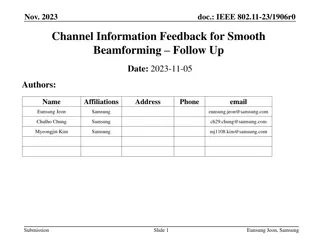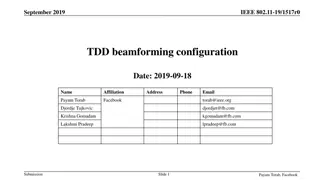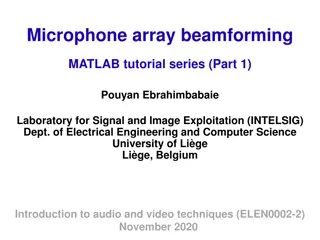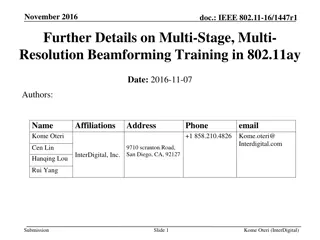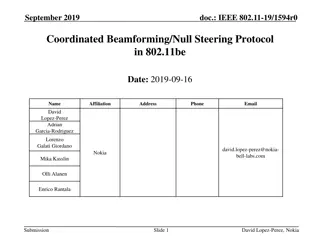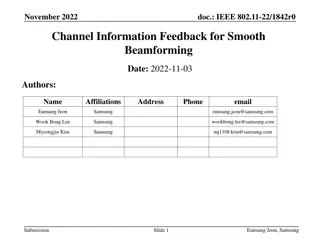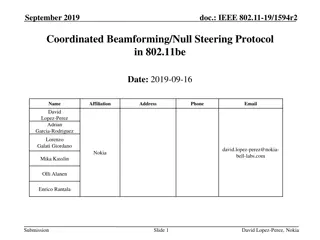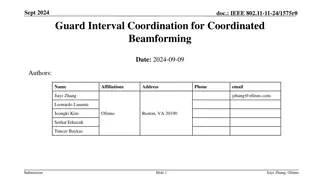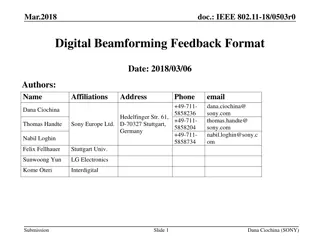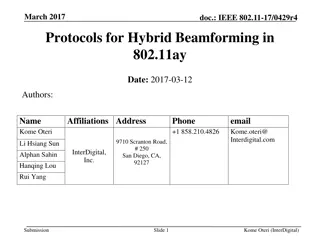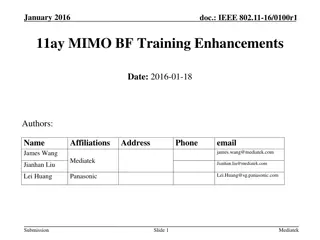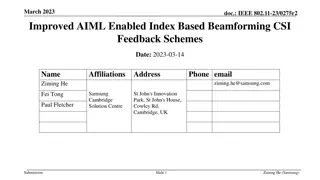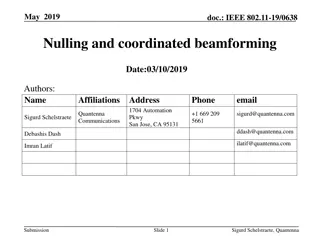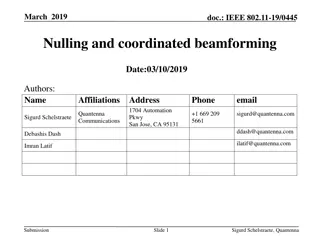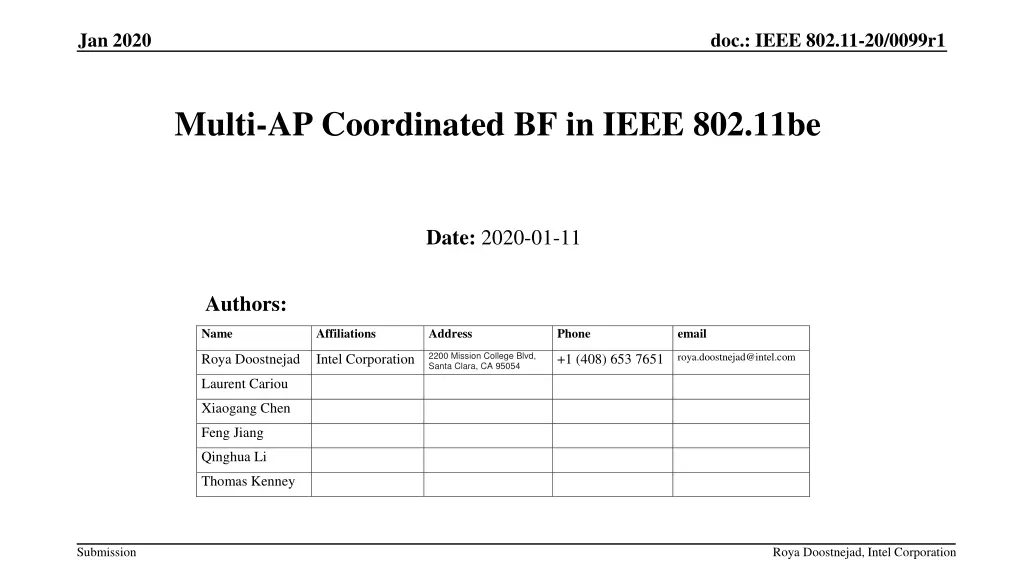
Multi-AP Coordinated Beamforming in IEEE 802.11be Standard
Discover the advantages of Multi-AP Coordinated Beamforming (CBF) proposed in IEEE 802.11-20/0099r1 document. Understand how CBF enhances performance, mitigates interference, and optimizes scheduling across multiple APs. Explore the mature study on Multi-AP CBF and its potential inclusion in the IEEE 802.11be standard for significant throughput gains in various scenarios.
Download Presentation

Please find below an Image/Link to download the presentation.
The content on the website is provided AS IS for your information and personal use only. It may not be sold, licensed, or shared on other websites without obtaining consent from the author. If you encounter any issues during the download, it is possible that the publisher has removed the file from their server.
You are allowed to download the files provided on this website for personal or commercial use, subject to the condition that they are used lawfully. All files are the property of their respective owners.
The content on the website is provided AS IS for your information and personal use only. It may not be sold, licensed, or shared on other websites without obtaining consent from the author.
E N D
Presentation Transcript
Jan 2020 doc.: IEEE 802.11-20/0099r1 Multi-AP Coordinated BF in IEEE 802.11be Date: 2020-01-11 Authors: Name Affiliations Address Phone email 2200 Mission College Blvd, Santa Clara, CA 95054 roya.doostnejad@intel.com Roya Doostnejad Intel Corporation +1 (408) 653 7651 Laurent Cariou Xiaogang Chen Feng Jiang Qinghua Li Thomas Kenney Submission Roya Doostnejad, Intel Corporation
Jan 2020 doc.: IEEE 802.11-20/0099r1 Coordinated BF Coordinated Beamforming (CBF) has been proposed in [1,2, 3] as one of the Multi-AP coordination schemes. o Multiple APs are coordinated and transmit in the same time/frequency (each to their own STAs) o There is no joint data processing across multiple APs o Data of Each STA is sent from a Single AP There have been several contributions covering performance gains and use cases for CBF, e.g. [3, 4, 5]. This is shown that CBF provides appealing performance/complexity trade-off. Submission Roya Doostnejad, Intel Corporation Slide 2
Jan 2020 doc.: IEEE 802.11-20/0099r1 Coordinated BF Transmitter: Interference mitigation (e.g. ZF) and coordinated Scheduling at each AP Multi-AP Channel Sounding is required to provide some information on interference channel. There have been several contributions on Multi-AP explicit channel sounding in specific for CBF, e.g. [6-10]. Implicit channel sounding is also proposed in [ 6, 11,12] to reduce network overhead. In summary, the study on Multi-AP Coordinated BF is mature enough to prove major Sum Throughput gain over single AP in many use cases. In this contribution, we recommend including Coordinated BF in .11be. In view of prioritization of technologies proposed in [13], CBF may be considered for Rel. 2. Submission Roya Doostnejad, Intel Corporation Slide 3
Jan 2020 doc.: IEEE 802.11-20/0099r1 SP Do you support adding Multi-AP Coordinated BF to 802.11be SFD as one of the multi-AP coordination schemes? Note: This feature is for rel. 2 Y N A Submission Roya Doostnejad, Intel Corporation Slide 4
Jan 2020 doc.: IEEE 802.11-20/0099r1 References [1]: Terminology for AP Coordination, doc.: IEEE 802.11-18/1926r2 [2]: Considerations on AP Coordination, doc.: IEEE 802.11-18/1576 [3]: Multi-AP Collaborative Beamforming in IEEE802.11, doc.: IEEE802.11-19/0772r1 [4]: Nulling and Coordinated Beamforming, doc.: IEEE802.11-19/0638 [5]: Performance of Coordinated Null Steering in 802.11be, doc.: IEEE802.11-19/1212 [6]: Coordinated Beamforming/Null Steering Protocol in 802.11be, doc.: IEEE802.11-19/1594r2 [7]: Sounding procedure in AP collaboration, doc.: IEEE802.11-19/1097r0 [8]: Sounding for AP Collaboration, doc.:IEEE802.11-19/1535r2 [9]: Consideration on Multi-AP Sounding, doc.: IEEE802.11-19/1134r1 [10]: Channel Sounding for Multi-AP CBF, doc.: IEEE802.11-20/0123 [11]: Implicit Channel Sounding in IEEE 802.11, doc.: IEEE802.11-19/0768r0 [12]: Multi-AP Implicit Channel Sounding, doc.: IEEE802.11-20/0089 [13]: Adopting a release framework to meet 802.11be timeline, doc.: IEEE 802.11-19/2153 Submission Roya Doostnejad, Intel Corporation Slide 5
Jan 2020 doc.: IEEE 802.11-20/0099r1 Back Up Submission Roya Doostnejad, Intel Corporation Slide 6
Jan 2020 doc.: IEEE 802.11-20/0099r1 Example I:Two Single-user Cells [3] AP: 4 antennas STA: 2 antennas 2 Overlapping Cells, distance between APs=45 m One STA in each cell. STA s distance from in-cell AP changes (1: 30 m) AP-2 AP-1 45 m 30 m Int. STA-1 STA-2 Submission Roya Doostnejad, Intel Corporation Slide 7
doc.: IEEE 802.11-20/0099r1 Example II: 3 APs [3] 3 overlapping APs: Single user/ AP1 and AP3, Two STAs/ MU MIMO/AP2 One SS to each STA AP-2 AP-1 AP-3 50 m 30 m STA-2 STA-3 STA-4 STA-1 Submission 8
Jan 2020 doc.: IEEE 802.11-20/0099r1 Example III: Two STAs per AP [3] Distance between APs=45 m, Two STA (MU-BF) in each cell (dropped randomly in (1:30 m) from in-cell AP). One SS to each STA AP-2 AP-1 30 m 45 m Int. STA-4 STA-2 STA-3 STA-1 1.4 1.8 Submission Roya Doostnejad, Intel Corporation Slide 9

